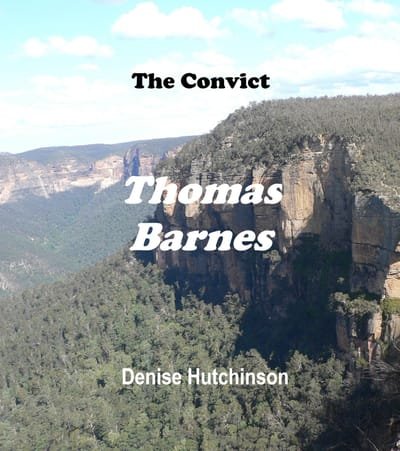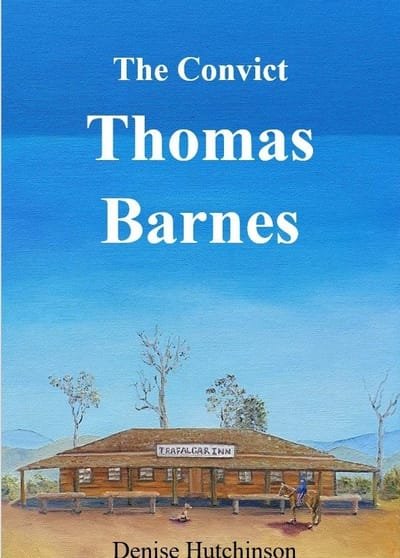Denise Hutchinson
AUTHOR
About the author
Her love for Australian colonial history was triggered by a primary school teacher who made convict history come to life. Growing up in the inner suburbs of Sydney, she was surrounded by reminders of the city’s convict past. Her father’s appreciation of the bush poets Henry Lawson, Banjo Paterson and C.J. Dennis, which he was always reciting, further heightened her interest in early Australian History.
It was when her sister sent her information on Lydia Astell and the Janus that Denise decided it was time to discover her roots. She did not want to find she was related to someone famous who lived in the fourteenth century, she wanted to know why her ancestors immigrated to Australia, and she had quite a few eureka moments.
Denise discovered her father had two direct convict ancestors, one in each of his parents ancestry, and three who had been associated by marriage, all of whom had been transported to Van Diemen’s Land. Her mother had four convict ancestors who had sailed to Port Jackson, including Lydia and Thomas Barnes.
The majority of her ancestors were assisted migrants fleeing the mass unemployment and poverty which was a result of the Agricultural and Industrial revolutions in England and a hand full who had been forced out of their homes during the Scottish clearances.
.
Once retired, Denise and her husband Col, became caravanners and spent a lot of their time discovering the towns which Lawson and Paterson wrote about in their poetry, as well as exploring the convict trails in Tasmania.
Now that she is back in Tasmania, Denise is enjoying her family and friends, and being part of her community. Her family research continues, and now she is on a quest to bring her convict family history to life in the form of historic novels, the first being The Convict Thomas Barnes.
Denise is willing to share any research information she has found on Lydia and Thomas Barnes, and is interested to hear from Barnes family researchers.
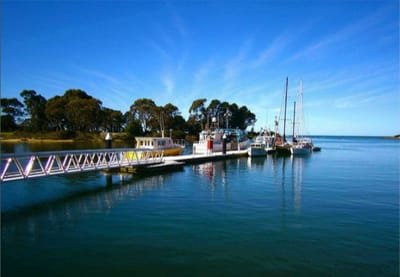
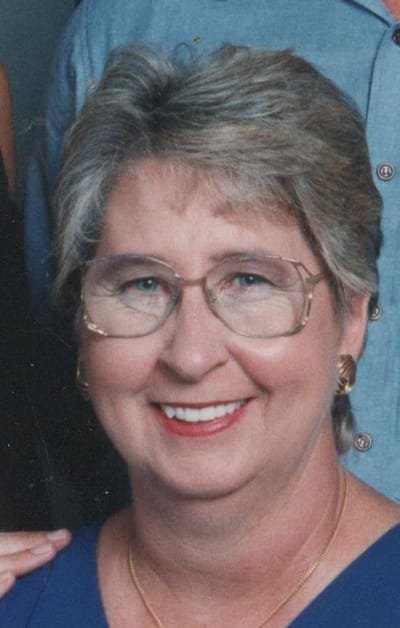
The Convict Thomas Barnes
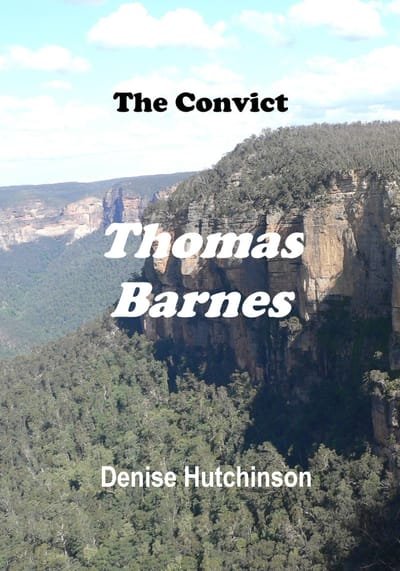
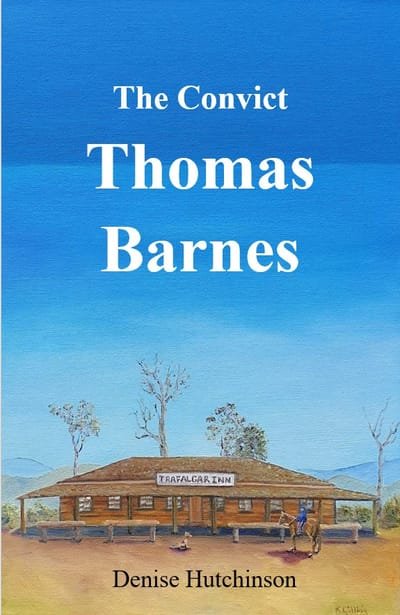
This is a book of fiction, based on research on Thomas and Lydia Barnes which has been gathered over many years.
The Story
Thomas Barnes had never expected to survive a year after arriving at Sydney Cove. His plan was to do what he was told and keep his nose clean to avoid the brutal punishments and deprivation which was a convict’s life.
He survived for thirty-nine years in the colony of New South Wales and became a father of three, and at the time of his death he was the grandfather of 16 children.
IN SYDNEY
He worked as a stonemason repairing the roads of Sydney Town, during which time he became drawn into the colonial politics between the governor and the Anglican Church when his marriage to Lydia Broomfield Astell was arranged by the Reverend Samuel Marsden.
IN KELSO
While a police constable stationed at Kelso, he watched Macquarie’s model town of Bathurst being built on the western side of the Macquarie River. He also witnessed the formation of the New South Wales Mounted Police Service.
IN BATHURST
He became gaoler at Bathurst Gaol and saw the mass hanging of ten convicts, members of the Ribbon Gang
Thomas also held a liquor license for the Trafalgar Inn at Honeysuckle Flats as well as the Golden Fleece Inn in Kelso on different occasions
This riveting book explores the developing colony of New South Wales through the eyes of convict Thomas Barnes. It is detailed in its description as the loves, lives and failures of Thomas and his family are vividly brought to life. The realistic and meticulous depiction of the conditions of convicts during their transportation and imprisonment in the colony, will delight enthusiasts of early Australian history.
The Convict Thomas Barnes has been published in printed form and as an eBook.
To order the paperback printed copy, click on the Buy Now link below.
Buy Now
To purchase the eBook click on the Buy Now link below
Buy Now
The convict Ellen Harper
This is a book of fiction based on research of Ellen Harper and James Theodore Harper
The Story
Birmingham
Ellen was the youngest child of a middle-class family in the industrial city of Birmingham, but she defied her father and married without his permission.
She was transported to Van Diemen's Land in 1848 with her ten-month old son, James, and found herself imprisoned on the probation hulk The Anson. When her son was 18 months old, he was sent to the Queens Orphan School at New Town and Ellen was assigned to a farmer northwest of Ross to assist his ill wife.
Ellen had arrived in Van Diemen's Land when the island prison was in chaos and facing bankruptcy; with the convicts and emancipists bearing the brunt of the anger and frustration of free settlers who wanted an end to transportation.
Campbell Town
Ellen eventually married John Forster who had been sent to Point Puer boy's prison as a 13-year-old, and now owned a blacksmith shop in Campbell Town. They had three children when John met an untimely death at age 26. From then on Ellen's life went downhill.
The story is predominately set in the towns of Campbell Town, Ross and Launceston and follows Ellens life as she survives years of violence, the loss of three husbands, two sons and a granddaughter in devastating circumstances and the despair which followed. The book is based on real characters and true events.
The main characters include Ellen, James Theodore Harper, John Forster, David Bestwick and Elizabeth Caroline Harper and is set in the tumultuous era of Tasmania's history.
The Convict Ellen Harper is available through Smashwords by following the link: https://www.smashwords.com/books/view/1167451 eBook formats include Kindle, Kobi, Amazon, ePub and PDF.
The printed version of Ellen Harper will be available in July 2023.
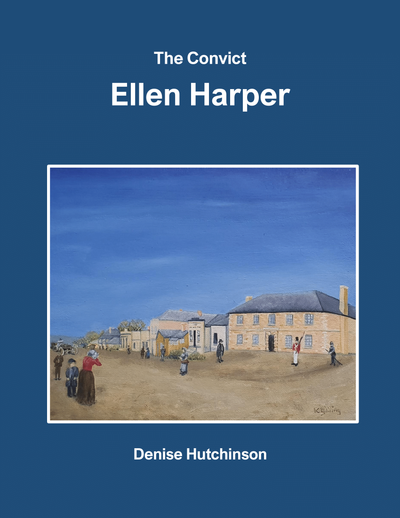
Interviews
Interview with Denise Hutchinson about The Convict Thomas Barnes
Q. You describe yourself as an amateur family historian. Why did you choose Thomas Barnes as the main character for your first book?
A. While Lydia Barnes is my favourite convict ancestor, Thomas was an enigma. The research I had found on him, which was limited, gave me no sense of who he was.
History tells us that many convict policemen were given that role on arrival in the colony because they were usually lifers and were intimidating and brutal. His muster sheets did not mention any behavioral problems. There was a report that he was promoted to the Parramatta constabulary for preventing a chain gang from escaping, and then the letter he wrote to Major Goulburn regarding Lydia’s intention to escape the colony. Some say that he dobbed on his fellow convicts and was trying to impress the powers that be, thus being given the promotion to Gaoler of the Bathurst prison. He did breach the liquor licensing act on several occasions while he held the licence at the Trafalgar Inn, but he did not appear to be a bully.
For the purposes of my book, I decided that Thomas used his head instead of his fists to resolve problems and managed to serve his time without upsetting too many officials. I also imagine that when Macquarie built the model city of Bathurst, the Governor would have expected that personnel posted to the town, would have been highly suitable for the positions and beyond reproach, including first gaoler appointed to the prison.
The fact that Thomas was married to the challenging Lydia for nearly four years when he wrote his letter to Goulburn, makes you wonder why he did not just let her abscond and find someone easier to live with.
The short answer to your question is because I did not know Thomas as well as I knew Lydia (and you do get to know your ancestors very well when you spend years researching them), I had more opportunity to develop his character and still stay with the facts that I knew about him.
Q. And yet you portrayed Lydia as the villain in the book.
A. Lydia was quite notorious in the colony and there are volumes of information available about her. She has even been referred to in historic research by various authors. Basically, she was non-conformist, manipulative and self-serving. She wrote several letters which came to the attention of the governors of the time, one resulting in a full magisterial inquiry. The Parramatta Female Factory was her second home, which gave her plenty of practical experience for when she became matron of the Bathurst Female factory for a short period of time when Thomas became gaoler in 1830. It was very easy to get a sense of who she was, and Lydia made an excellent villain.
Q. Your novel has been described as historical with a little fiction thrown in as opposed to fiction with a little bit of history included.
A. I love Australian colonial history. I think a lot of us forget that the convicts were involved in building magnificent structures in other towns in Australia other than Sydney and Hobart. I had been to Bathurst on numerous occasions not realising the significance of the city to my own family history, nor that it had been a planned purpose-built city until I discovered Thomas Barnes. While researching him, I learnt the history of the Bathurst area which was completely unexpected and fascinating. I decided then that Kelso and Bathurst had to be included as characters in my book. I hope to return to Bathurst in the future where I will expect to see the city from a totally different perspective.
Q. How long have you been researching this book?
A. Six months, that is if you don’t count the countless years I have been researching my family history. I obtained my first piece of ancestry information from my sister Michele about 30 plus years ago. It was the story of the Janus and my research started from there. My search covered both parent’s ancestors, and as my earliest ancestor arrived in chains in 1804, there were quite a few predecessors to discover. In terms of the book, I was reasonably familiar with the early history of government in New South Wales and did a few facts checks as I wrote. I knew nothing about the western plains, and my research on Bathurst took place while the book was being written, which influenced the storyline on several occasions. Thank goodness for Mrs Google.
Q. How long did it take to write The Convict Thomas Barnes?
A. Six months. I had written a family history reference book for my children and siblings, and while it was thoroughly researched and presented as a research document, it was still just a bunch of names and dates with photographs thrown in, a bit boring, and not giving a real sense of who those people were. My sister Lesley suggested that I pick a favourite ancestor and write a novel. In April 2020 when northwest Tasmania was in level one lockdown, I started writing. The beauty of writing an historical novel is that the plot is already in place and the story flowed easily. When people ask me what I did during Covid, I tell them I wrote and published a book.
Q. Is there a second book coming?
A. I have started on a book about Ellen Harper, another convict ancestor who was transported to Van Diemen’s Land in 1848 from Birmingham. Unlike Lydia, she suffered some terrible personal losses during her life in the colony and did not have the spirit or determination to improve her situation; she seemed to stumble from one traumatic event to another. The working title is ‘Death to Rats’.
Q. Where will this book be set?
A. Campbell Town, Tasmania. Ellen spent most of her life in the midlands of Tasmania. Campbell Town was a wild and dangerous place in colonial times. It was one of four garrison towns linking Hobart to Launceston, and then became a major probation station where most convicts sent to Van Diemen’s Land passed through the town sooner or later. Numerous convicts from Norfolk Island were relocated to the area as pardoned settlers and were given land grants when that penal settlement was closed. It is a significant historical convict area in Tasmania and has a number of World Heritage listed sites in close proximity.
Q. When can we expect the book to be published?
A. Hopefully by June next year. It will initially be published on Smashwords in digital format as was The Convict Thomas Barnes when it was first published.
Interview with Denise Hutchinson about The Convict Ellen Harper
Q. This is the second book you have written about convicts. How does this compare to your first book, The Convict Thomas Barnes?
A. The Convict Ellen Harper was a completely different experience to writing about Thomas. Ellen had a very difficult life in Tasmania and encountered a number of enormous losses. Her way of coping was to get drunk, which only brought about further problems. In her lifetime she grieved the loss four husbands, gave birth to eight children and mourned the death of four of them. As well, while researching the book, there were a number of issues regarding the savage treatment of convicts in Van Diemen’s Land and the attitude of free settlers toward them that made the background to Ellen’s story much more complex and very sombre, in as much that I thought seriously about not writing it.
Q. Can you give me an example?
A. I was familiar with the convict history of Tasmania through research into my ancestry. For this book I had to look deeper into the politics of the day, the dynamics of the colony and how it impacted on not only those who were in the colony, but also on those living in distant lands. What I found was that Van Diemen’s Land was a very dark place during the first seventy years of colonisation. The governors, of Van Diemen’s Land, particularly George Arthur, were viciously cruel to the serving convicts, as well, he was responsible for almost destroying the oldest and purest indigenous nation on the planet. We are all aware of the Stolen Generations, and its consequence on the First Nations People of Australia. The Lost Generation was named for the many thousands of people who died in Europe during World War One. Looking at British convict transportation where 162,000 people alone were sent to Australia during an 80-year period, how many men, women and children were exiled from their homeland and sent to British colonies all over the world during the three hundred years of British convict transportation which ended in the early 1900’s? Maybe, it was a lower-class purge by the English upper classes protecting their wealth and social standing. Would the Convicts be called the Exiled Generations? I have trouble in comprehending how a nation can inflict so much pain and suffering on their own people, and then compound that suffering with inhumane punishments and conditions once the banished had arrived at their place of incarceration. Tasmania did well to survive that era.
Q. Describe the character of Ellen.
A. Ellen had been brought up by a strict father and followed the teachings of the Anglican Church. When she found a little freedom, she became slightly rebellious, being caught up in petty crime. She defied her father and married James Evans and ended up on a boat to Van Diemen’s Land with their young son Jimmie. Throughout her life, she had been conflicted between her religious beliefs and the “new rules” of colonial Van Diemen’s Land. When things went wrong for her, she believed God was punishing her, and made decisions which caused further misfortune to her and her family. When Ellen arrived in Van Diemen’s Land, she had her son taken from her and placed in the Queens’s Orphan School and was assigned to an abusive property owner who lived one hundred and twenty miles from her son. To cope with her life, Ellen discovered and became an alcoholic which she struggled with for the rest of her life. The story is set predominantly in Campbell Town in the midlands of Tasmania. There is a location in Campbell Town on the southern side of the Elizabeth River which the locals have named Tragedy Hill, where one of Ellen’s sons and her five-year-old granddaughter were murdered with rat poison. Even though Ellen turned to alcohol to get her through life, she did have a lot of inner strength which she was able to draw on when needed.
Q. How long has it taken to write this book?
A. I started this book three years before I began The Convict Thomas Barnes, which was published twelve months ago. There were so many crises in Ellen’s life both before she left Birmingham and when she arrived in the colony, that at times she was difficult to write about. The person in her life who really affected me, was her son James. He arrived in the colony as a free settler at the age of 10 months and ended up imprisoned in the orphan school, which had a long-term impact on him, as it did to most of the children who were placed in those schools. They were not prisoners, had committed no crimes, but were treated just as badly as any convicts were. We tend to overlook that the majority of convicts in Van Diemen’s Land and New South Wales would have been suffering Post Traumatic Stress Disorder from being torn from their families and homeland, which was exacerbated by the ongoing abuse they received in the colony, even after they were pardoned. To answer to your question, the book would probably have taken me be five years to write and twenty-five years to research.
Q. Is there a third book on the way?
A. Hopefully there will be. I have an ancestor named David Heath, who was transported to Van Diemen’s Land for Machinery Breaking during the Swing Riots in the 1830’s in relationship to the Agricultural and Industrial Revolutions. He was a convict who was treated well because he was a ploughman, his services were very much needed to help produce food in the colony, and he saw a different side to Van Diemen’s Land than Ellen did. He had been assigned to a landowner at Old Beach, near Hobart and eventually got a land grant at Bushy Park when he was pardoned. That book is two or three years away.
Q. When do you expect to have a printed copy of Ellen Harper printed.
A By June 2023, if all goes to plan. It will be for sale through my web site.
Where To Buy
The digital version of "The Convict Thomas Barnes" is available for $7.50. The price may vary slightly depending on the current value of the US dollar.
The eBook is available in a number of formats to suit all eReaders.
This digital book can be purchased online by clicking:
Smashwords
The printed format can be purchased directly from the Store for $49.95 which includes $10.00 postage and handling.
The book, which is in paperback format and printed in Australia, is a quality product and contains 580 pages.
If you are purchasing more than one copy to the same address, please contact Denise directly for amended postage rates.
enquiries
.
